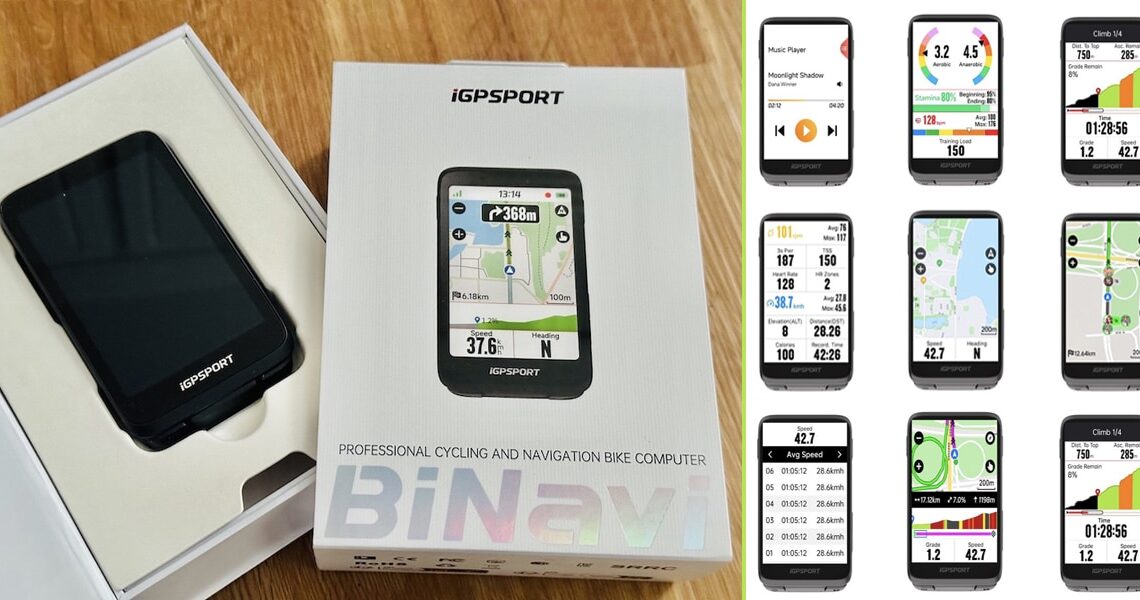
iGPSPORT is probably a company a lot of PEZ readers don’t know about (unless you’re a reader in Asia or someone who is familiar with Asian brands). But they’ve been around for a while. They introduced their first bike computer in 2012 with new models ever since. In 2023, they introduced their first smart sport watch. And in 2024, 4-time TdF winner (as well as having won the Vuelta twice and Giro once — so one of only seven riders to have won all three Grand Tours), Chris Froome, became an iGPSPORT brand ambassador. Their newest bike computer is the BiNavi.
iGPSPORT BiNavi Bike Computer – $249.90:

iGPSPORT sez:
- Screen size: 3.5”
- Screen resolution: 320X480
- Touchscreen: Color touchscreen
- Appearance size: 101×60×14.5 mm
- Weight: 103g
- Buttons: 6
- Language: Multiple languages
- Battery type: Cobalt battery
- Battery capacity: 1250mAh
- Charging time: 1.5 hours
- Battery life: 35+ hours
- USB: Type-C
- Memory: 32GB
- Waterproof: IPX7
- GPS system: Full GNSS+Dual-band (L1+L5)
- Temperature: -10℃ to 50℃
- Speed sensor: (BLE/ANT+)
- Cadence sensor: (BLE/ANT+)
- Heart rate sensor: (BLE/ANT+)
- Power meter: (ANT+)

One gram heavier than spec weight, but who’s counting?
PEZ sez: Here’s my BLUF (bottom line up front) …
The iGPSPORT BiNavi can do what you expect a bike computer to do, e.g., measure speed, distance, cadence, power, etc., but — as the name implies — its focus leans towards navigation. The BiNavi packs a lot of punch at a competitive price point. The similarly featured Garmin Edge Explore 2 is $50 more (retail) but has a smaller 3″ vs 3.5″ screen. If you’re in the market for a bike computer designed more to help you navigate (I’m thinking particularly gravel and adventure riding and even commuting), the iGPSPORT BiNavi is a ‘droid worth looking at.

In addition to the BikeNavi (center), you get: (1) rubber band handlebar mount (quarter-turn Garmin-like), (2) Quick Start Manual, (3) glass screen protector, (4) rubber surround bumper, (5) USB-A to USB-C charging cord, and (6) lanyard

The BiNavi PEZ got came fully charged, but it’s USB-C when it comes time to recharge
I’m not going to do an in-depth review that tries to cover everything the BiNavi can do, but to give you some idea of some of what it can do:




If you fall into the category of aging eyes (mine are Lasik-corrected but I need reading glasses), you’ll appreciate the BiNavi’s large screen and crisp color display. It’s a touchscreen that allow you to navigate much like you would on your smartphone:
- Tap (short press) – Select and enable
- Long press – Enter editing mode/Trigger hidden features
- Swipe up – Scroll the list or content upwards
- Swipe down – Scroll the list or content downwards
- Swipe left – Flip the page to the left
- Swipe right – Flip the page to the right
- Drag – Move
- Pinch – Zoom in or out

In addition to touchscreen control, the BiNavi has six buttons: (1) Power on/off, (2) Lap/quick settings, (3) Ride start/pause, (4) Switch down/right, (5) Switch up/left, (6) Select/enter ride menu
As is the case with most electronic devices, there’s some set up (and learning curve, but not a steep one) involved to configure the BiNavi. That’s what the iGPSPORT app (either iOS or Android) is for. I won’t walk through the whole process, but the first thing you need to do is pair the BiNavi with the app.



Once the BiNavi is paired to your phone, you can use the app to pair sensors and configure different settings. And don’t forget to update the firmware!
The iGPSPORT BiNavi has 15(!) different pages/screens you can scroll through.





Each page/screen can be configured to your liking. I decided to reconfigure the main screen.


If you ride to power, you’ll appreciate being able to display it as the largest data field and with your current power in a different color
Honestly, 15 pages is way more than I need for my riding (but it’s nice to have them if you want them). Fortunately, you can use the app to toggle pages on or off, as well re-order them.




I really only need the main screen and the map for my riding in the Lowcountry
One thing worth noting is that the BiNavi that PEZ got did not come with any US maps pre-loaded. I had to go to the iGPSPORT web page to download maps. To load a map to the BiNavi:
- Download the required map file from the iGPSPORT website to your computer
- Turn off the BiNavi and connect it to your computer via a USB data cable
- Put the map file in the iGPSPORT / Maps directory of the computer (this took about 20 minutes for the US-south map files — other US maps are: US-west, US-pacific, US-northeast, US-midwest)

If you already have a Garmin mount, the BiNavi uses the same quarter twist-and-turn
Riding with the BiNavi is not a whole lot different than any other bike computer:
- Turn it on (left top button)
- Select what type of bike/ride on the touchscreen (in my case, Road)
- Tap the screen and the ride status bar will appear at the bottom and then tap the arrow on the bottom right to start the ride
- Alternatively, you can start the ride with the bottom right button

- When your ride is over, tap the screen and the ride status bar will appear at the bottom and then tap the checkered flag on the bottom left to end the ride
- Alternatively, you can end the ride with the bottom right button
- Use the right top button to enter the riding page and select SAVE to save the ride

I said at the beginning that the iGPSPORT BiNavi was designed/intended as a navigation unit. If you create maps in Strava or Komoot, you can them directly via the iGPSPORT app. I use RideWithGPS to create maps, so here’s what I had to do:
- I created a test route in RideWithGPS
- Downloaded the route as a GPS Track .gpx file (what iGPSPORT recommends)
- Uploaded the .gpx file to my iGPSPORT account on the web (not my iGPSPORT phone app)
- I could then use the iGPSPORT phone app to load the route to the BiNavi:


On my test route, the navigation worked well (sorry I don’t have pics!) There are prominent, easy to see/read pop-up alerts that provide ample notice of an upcoming turn. And a pop-up alert at the turn. (NOTE: I turned off alert tones so didn’t get the warning beeps for turns. If you’re wearing Bluetooth headphones connected to your phone, you will get voice alerts for turns. I also turned off the flashing screen feature.) If you miss or make a wrong turn, don’t blame the BiNavi!
When I purposely veered off course, the re-routing (double red arrowheads) worked as well as other bike navigation I’ve used (Garmin, Wahoo, Hammerhead, Coros). Meaning, a lot of times it would just want you to make a u-turn (not always practical). Otherwise, it would take you to the next place you could turn to put you back on the route. (NOTE: The algorithm doesn’t always route you back to where you went off course. If you are closer to another section of the route — including a section taking you back to where you started — it will route you there.) If you’re in unfamiliar environs, the navigation will get you to where you need to be. But from my experience, if you know where you are and where you’re going, a lot of times the human can be smarter than the algorithm.

The green is the route and the double arrow heads show direction of travel
I said I wasn’t going to cover everything about the iGPSPORT BiNavi (it has a lot to offer), but hopefully I’ve done enough to whet your appetite.
The truth is that down here in the Lowcountry, I don’t really have a use for all off the BiNavi’s navigation features because the road system that’s bike-rideable is relatively limited and I don’t need the navigation features to get around/find my way around. Plus it’s virtually impossible to get lost. If I was still up in Babylon on the Potomac, I would be able to use more of the navigation features because of the denser road system and there are just more places to ride.
But just because I can’t take advantage of the navigation features isn’t a reason for me not to ride the iGPSPORT BiNavi. It does everything I need a bike computer to do. It’s more than capable and a solid unit at a price point that won’t break the bank. If you’re in the market for a new bike computer, it’s a worthy option that should be on your shopping radar.
Note: If you have other experiences with gear or something to add, drop us a line. We don’t claim to know everything (we just imply it at times). Give us a pat on the back if you like the reviews or a slap in the head if you feel the need!
PezCycling News and the author ask that you contact the manufacturers before using any products you see here. Only the manufacturer can provide accurate and complete information on proper/safe use, handling, maintenance, and or installation of products as well as any conditional information or product limitations.
The post iGPSPORT BiNavi Bike Computer Review appeared first on PezCycling News.



